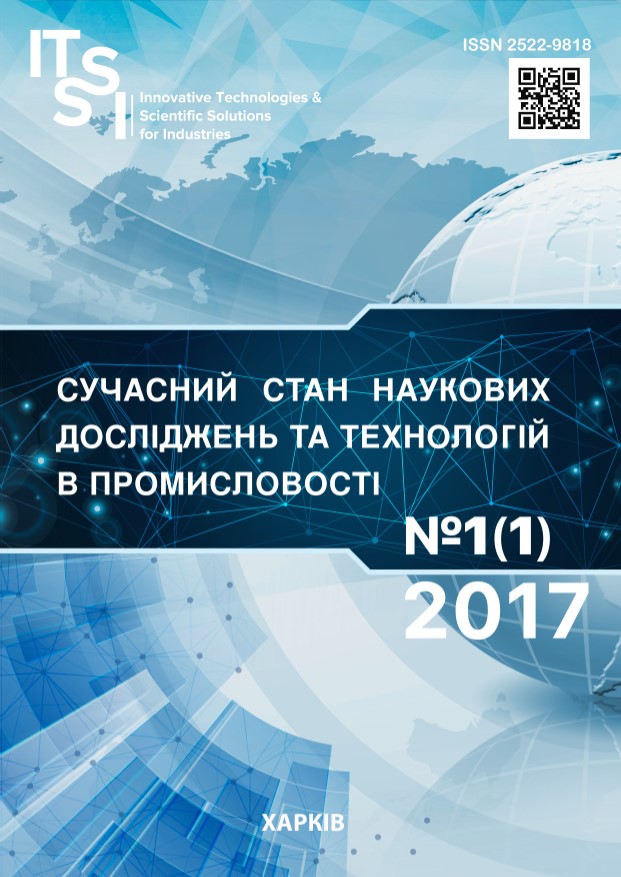ENSURING PERSONNEL SECURITY OF INDUSTRIAL ENTERPRISES UNDER CONDITIONS OF ENVIRONMENTAL CONFLICTS
DOI:
https://doi.org/10.30837/2522-9818.2017.1.103Keywords:
personnel security, conflict environment, industrial enterprises, integral indicator of personnel security of enterprises of the industry, personnel security provision, personnel security profiles of the enterpriseAbstract
The subject of research of the article is theoretical and methodological approaches to the personnel security of enterprises of the industry provision in a conflict environment. The goal is the substantiation of scientific and theoretical provisions and development of practical recommendations for improving the provision of personnel security for industrial enterprises in a conflict environment. Objectives: the essence and the basic elements of personnel safety of the enterprise as object of management in the conditions of occurrence of conflicts are defined; of the system of indicators of the assessment of the state of personnel security at industrial enterprises is analysed; the indicators of the assessment of the personnel security status have been researched, the personnel safety profiles have been constructed on the example of industrial enterprises; an integral index of the personnel security of industrial enterprises is defined; ways of countering threats to ensure personnel security of the enterprise are improved. It is used general scientific methods, such as: system analysis, structural analysis, methods of financial and economic and statistical analysis, graphical and analytical methods for visualization of research results. The following results are obtained. The article presents the methodical approach developed by the authors to the definition of the integral index of personnel security of enterprises of the industry, which is based on a comprehensive assessment of the indicators of financial and economic activity of enterprises and indicators of the personnel system efficiency. By organizing indicators for assessing the status of personnel security, 32 indicators have been selected based on the components of personnel security, namely, socio-motivational safety, occupational safety, non-conflict security and safety of life. The personnel security profiles of the enterprise were built and the group of industrial enterprises was grouped according to the profile of personnel security with interval characteristics, taking into account the state of personnel security in a conflict environment. The applied part was realized by performing calculations using the example of the industries of the Kharkov region selected for research. Conclusions. The article investigates the system of personnel security and the basis of its provision at the enterprises of the industry. The authors analyze different approaches to the interpretation of the category "personnel security" and proposed their own definition of this concept. Personnel security is considered as a synthetic category of economic theory, personnel management, sociology of management and labor economics, and is defined as the activity to create conditions for the stable functioning and development of an enterprise, which ensures the protection of the interests of the enterprise from the risks and threats associated with its own personnel and the personnel themselves from internal and external threats such as blackmail, revenge on competitors, attacks on the lives and health of employees etc. Based on the conducted calculations, the existing level of personnel security was analyzed and the recommendations for countering the threats to personnel security have been developed on the example of selected enterprises for the Kharkiv region industry. The proposed measures allow to increase the efficiency of the activity and reduce the risks from the criminal actions of employees.References
Shvets, N. K. (2006), "Methods of detection and preservation of personnel security, or how to overcome abuse of personnel", Personnel, No. 5, pp. 31-38.
Petrov, M. I. (2002), "Economic security of the enterprise: essence, interpretation, point of view", Manager, No. 1 (17), pp. 67-71.
Chumarin, I. G. (2003), "What is the personnel security of the company?", Personnel of enterprise, No. 2, available at: http://www.kapr.ru/articles/2003/2/519.html.
Jobava, A. "Features of staff selection in pharmacy networks of St. Petersburg", available at: http://www.selectium.spb.ru.
Goncharenko, L. P. (ed) (2007), Economic and national security: study, Economics, Moscow, 543 p.
Heyets, V. M., Kizim, M. O., Klebanov, T. S. et al. (2006), Modeling of economic security: the state, region, enterprise: Monograph, VD "INZHEK", Kharkiv, 240 p.
Myryushchenko, A. L. "The essence of personnel security", available at: http://kadry.ucoz.ru/publ/8-l-0-6.
Lyubavskaya, L. I., Belyaykin, D. V. (2010), Personnel Security as a Factor of Competitiveness in the Sphere of Banking Entrepreneurship: Study. allowance, NF RPGEU, Novosibirsk, 104 p.
Kybanov, A. Ya. "Personnel management organization", available at: http://econom-lib.ru/4.php
"Order of the Ministry of Economy of Ukraine "On Approval of Methodology for Calculating the Level of Economic Security of Ukraine" No. 60 of 02.03.2007", available at: http://www.uazakon.com/documents/date_6s/pg_gewqwi/pg2.htm.
Downloads
How to Cite
Issue
Section
License
Copyright (c) 2018 Tetiana Momot, Zhang Haoyuy, Daryna Momot

This work is licensed under a Creative Commons Attribution-NonCommercial-ShareAlike 4.0 International License.
Our journal abides by the Creative Commons copyright rights and permissions for open access journals.
Authors who publish with this journal agree to the following terms:
Authors hold the copyright without restrictions and grant the journal right of first publication with the work simultaneously licensed under a Creative Commons Attribution-NonCommercial-ShareAlike 4.0 International License (CC BY-NC-SA 4.0) that allows others to share the work with an acknowledgment of the work's authorship and initial publication in this journal.
Authors are able to enter into separate, additional contractual arrangements for the non-commercial and non-exclusive distribution of the journal's published version of the work (e.g., post it to an institutional repository or publish it in a book), with an acknowledgment of its initial publication in this journal.
Authors are permitted and encouraged to post their published work online (e.g., in institutional repositories or on their website) as it can lead to productive exchanges, as well as earlier and greater citation of published work.














